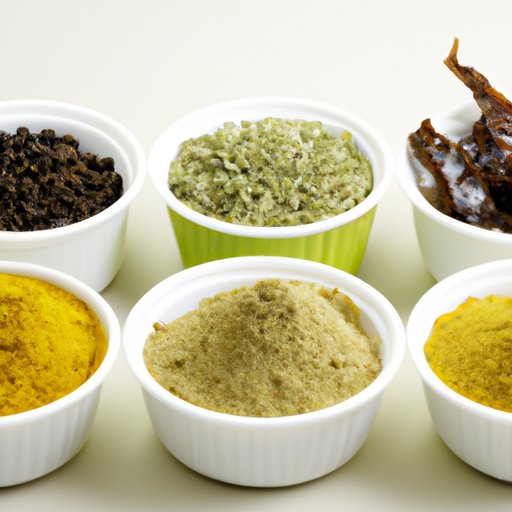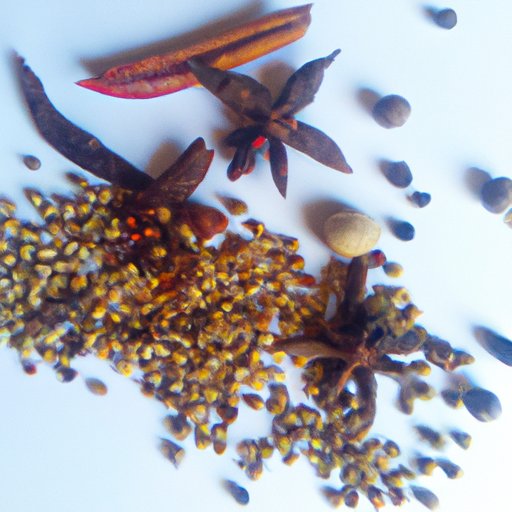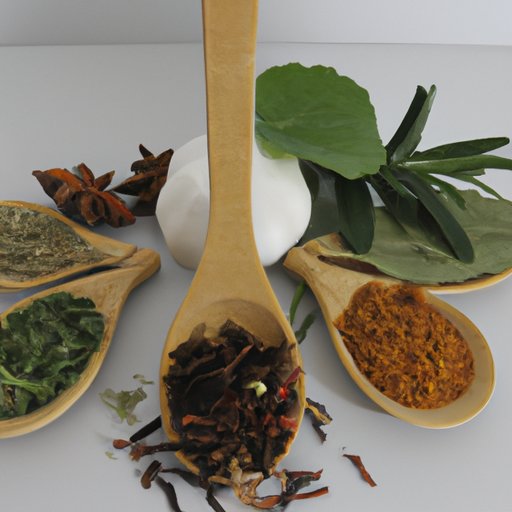Introduction
Spices have been used in cooking for centuries, and they have become an integral part of many cultures around the world. But what exactly are spices? Spices are the dried parts of plants, including seeds, bark, roots, and fruits, that are used to add flavor and aroma to food. They can be used fresh, dried, or ground into a powder.
In addition to adding flavor and aroma to dishes, spices also offer numerous health benefits. Studies have shown that spices are rich in vitamins and minerals, as well as powerful antioxidants that can help protect the body from damage caused by free radicals. They also contain anti-inflammatory properties that can help reduce inflammation in the body.

Nutritional Benefits of Common Spices
Let’s take a closer look at some of the most popular spices and their nutritional benefits:
Turmeric
Turmeric is a popular spice used in Indian cuisine. It has a pungent, earthy flavor and is a key ingredient in curry powder. Turmeric contains curcumin, which is a powerful antioxidant that can help reduce inflammation and may even help lower cholesterol levels.
Cinnamon
Cinnamon is a sweet and spicy spice that is often used in baking. It contains cinnamaldehyde, which is a compound that has been shown to reduce inflammation and improve insulin sensitivity. Cinnamon is also high in manganese, iron, and calcium.
Ginger
Ginger is a pungent root that is commonly used in Asian cuisine. It contains gingerol, which is a compound that has been found to help reduce nausea and pain. Ginger is also a good source of vitamin C, magnesium, and potassium.
Garlic
Garlic is a flavorful bulb that is used in many different dishes. It contains allicin, which is an antioxidant that helps reduce inflammation and protect the body from damage caused by free radicals. Garlic is also high in vitamins B6 and C, as well as selenium and manganese.
Coriander
Coriander is a fragrant herb that is often used in Middle Eastern and Indian cuisine. It contains carvacrol and linalool, which are compounds that have been found to help reduce inflammation and improve digestion. Coriander is also a good source of dietary fiber, iron, and magnesium.
Cardamom
Cardamom is a fragrant spice that is often used in Indian and Scandinavian cuisine. It contains cineole, which is an antioxidant that helps reduce inflammation and may even help protect against cancer. Cardamom is also high in manganese, iron, and zinc.
Cloves
Cloves are the dried flower buds of a tree native to Indonesia. They have a strong, spicy flavor and are often used in baking. Cloves contain eugenol, which is a compound that has been found to help reduce inflammation and improve blood circulation. Cloves are also high in manganese, vitamin K, and dietary fiber.

Herbs and Spices: The Spice of Life for Good Health
Herbs are also an important part of a healthy diet. Herbs are the leaves, stems, flowers, and roots of plants that are used to flavor food. Unlike spices, herbs are usually used fresh rather than dried.
Herbs offer many of the same health benefits as spices. They are rich in vitamins and minerals, and many of them contain powerful antioxidants that can help reduce inflammation and protect the body from damage caused by free radicals. Herbs can also help improve digestion and strengthen the immune system.
Exploring the Health Benefits of Popular Culinary Spices
Now let’s take a look at some of the most popular culinary spices and their health benefits:
Cumin
Cumin is a fragrant spice that is often used in Mexican and Indian cuisine. It contains thymoquinone, which is a compound that has been found to help reduce inflammation and boost the immune system. Cumin is also a good source of iron, calcium, and magnesium.
Paprika
Paprika is a mild, sweet spice that is often used in Hungarian cuisine. It contains capsaicin, which is an antioxidant that helps reduce inflammation and may even help protect against cancer. Paprika is also high in vitamins A and C, as well as potassium and iron.
Cayenne Pepper
Cayenne pepper is a hot and spicy pepper that is often used in Mexican and Indian cuisine. It contains capsaicin, which is an antioxidant that helps reduce inflammation and may even help lower cholesterol levels. Cayenne pepper is also a good source of vitamins A, C, and E, as well as iron and magnesium.
Black Pepper
Black pepper is a pungent spice that is often used in Italian and Indian cuisine. It contains piperine, which is an antioxidant that helps reduce inflammation and may even help protect against cancer. Black pepper is also high in manganese, vitamin K, and iron.
Mustard
Mustard is a pungent condiment that is often used in sandwiches and dressings. It contains glucosinolates, which are compounds that have been found to help reduce inflammation and boost the immune system. Mustard is also a good source of dietary fiber, vitamin A, and iron.
An Overview of the Medicinal Properties of Spices
Spices offer numerous medicinal properties that can help promote overall health and wellness. Here are some of the major benefits of incorporating spices into your diet:
Antioxidants
Spices are rich in antioxidants, which are compounds that help protect the body from damage caused by free radicals. Antioxidants can help reduce inflammation and may even help protect against certain diseases.
Anti-inflammatory Properties
Many spices contain compounds that have been found to help reduce inflammation in the body. This can help relieve pain and swelling associated with certain conditions, such as arthritis and gout.
Immune System Support
Spices are also known to help boost the immune system. Many spices contain compounds that can help fight off infections and reduce the risk of illness.

How to Incorporate Spices into Your Diet for Optimal Health
Adding spices to your diet is a great way to get all the health benefits they offer. Here are some tips for incorporating spices into your meals:
Tips for Adding Spices to Meals
• Add spices to soups, stews, and sauces for extra flavor.
• Sprinkle spices over salads, omelets, and vegetables for added flavor.
• Use spices in marinades and rubs for grilled meats and vegetables.
• Mix spices into yogurt, hummus, and dips for extra flavor.
• Add spices to smoothies and juices for a nutritional boost.
Recipes Incorporating Spices
There are endless possibilities when it comes to incorporating spices into your meals. Here are some delicious recipes that use spices:
- Lemon-Ginger Salmon
- Coconut Curry Chicken
- Tandoori Chicken Skewers
- Roasted Cauliflower with Turmeric
- Garlic-Rosemary Roasted Potatoes
Spice Blends to Enhance Flavor
If you want to add more flavor to your meals without having to buy multiple spices, you can try making your own spice blends. Here are some easy recipes for homemade spice blends:
- Taco Seasoning: chili powder, cumin, garlic powder, oregano, paprika, and salt.
- Curry Powder: turmeric, coriander, cumin, ginger, black pepper, cardamom, cinnamon, and cloves.
- Italian Seasoning: oregano, basil, rosemary, thyme, garlic powder, onion powder, and red pepper flakes.
- Ras el Hanout: cumin, coriander, cardamom, cinnamon, ginger, nutmeg, turmeric, pepper, and cloves.
Conclusion
Spices are a great way to add flavor and nutrition to your meals. They offer numerous health benefits, including antioxidants, anti-inflammatory properties, and immune system support. By incorporating spices into your diet, you can enjoy all the health benefits they offer while still enjoying delicious meals.
(Note: Is this article not meeting your expectations? Do you have knowledge or insights to share? Unlock new opportunities and expand your reach by joining our authors team. Click Registration to join us and share your expertise with our readers.)
